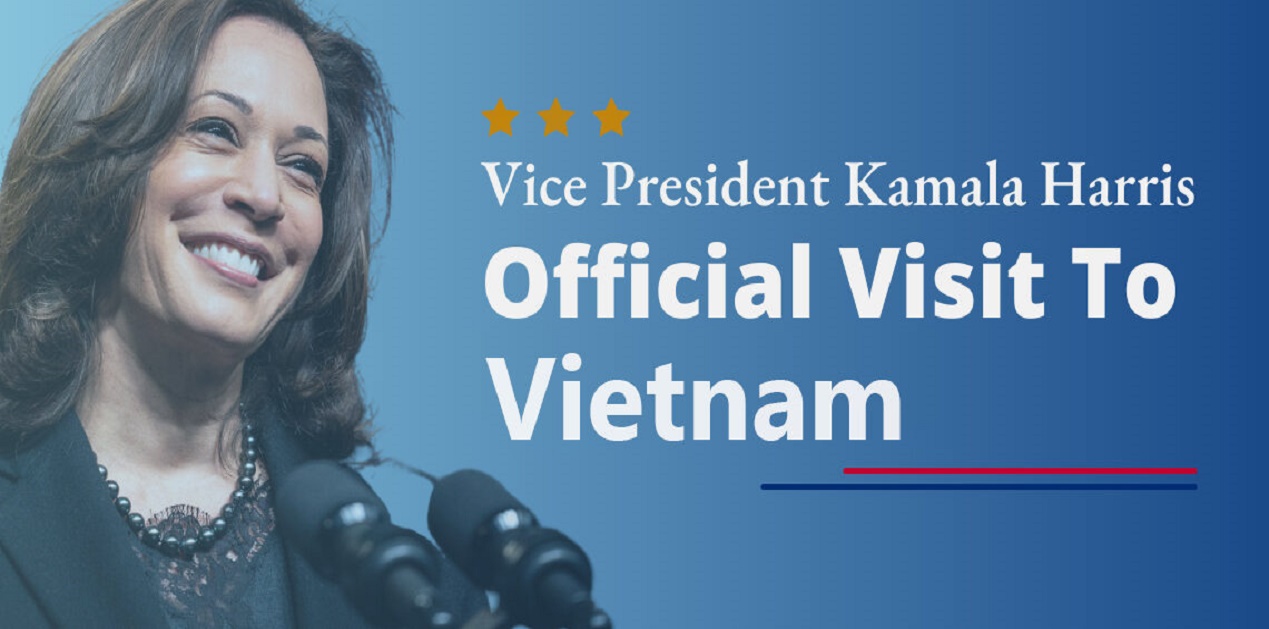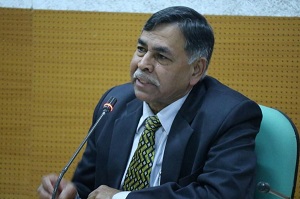Even as the US President Joe Biden is facing another big challenge in Afghanistan following his decision to withdraw troops and takeover by the Taliban, Biden’s foreign policy challenge in the Indo-Pacific front has no less diminished. China remains as the elephant in the room and needs to be managed. The visit of the US Vice President Kamala Harris to Singapore and Vietnam and making statements in Singapore and Hanoi on how China continues to remain as a threat needs to be understood in perspective. In the capitals of both the Southeast Asian countries she assured that the US stands with allies and partners in face of China’s threats. Being the first US Vice President to visit Vietnam, Kamala Harris chose to single out Beijing’s “bullying” of its smaller neighbour countries amid tensions in the South China Sea.
In Singapore, Harris met with Singapore President Halimah Yacob and Prime Minister Lee Hsien Loong. She delivered a major foreign policy speech at Gardens by the Bay before departing for Vietnam on the second leg of her Southeast Asia trip. She remarked that China continues to “coerce" and "intimidate" as part of its claims to the South China Sea. She observed: "Our vision includes freedom of navigation, which is vital to us all. The livelihoods of millions of dollars in trade that flow through these sea lanes each day. And yet, in the South China Sea, we know that Beijing continues to coerce, to intimidate and to make claims to the vast majority in the South China Sea”.1
It is not only the US but all the four countries – the US, India, Japan and Australia – are on the same page that Beijing’s maritime claims around the Spratly Islands and neighbouring reefs and shoals in the South China Sea are “unlawful” and were rejected in July 2016 by the five-judge tribunal appointed by the Permanent Court of Arbitration (PCA) based in The Hague adjudicating on a petition filed by the Philippines h. The tribunal ruled that China’s historic rights to resources within the sea areas falling within the ‘nine-dash line’ have no legal basis. China not only boycotted the tribunal questioning its legality but asserts that its emperors discovered the islands hundreds of years ago and have been exercising control over the area throughout the history. Beijing is aware that the tribunal lacks any enforcing authority to its rulings and therefore rejected the ruling.
The core of Harris’s remarks was that Beijing’s actions continue to undermine the rules-based order and threatens the sovereignty of nations. Harris’s observations were a clarification of the stand chosen by the four Quad countries about advancing an optimistic vision of the partnership in which the economic vision is a critical part. Harris expressed her anguish over the developments in Myanmar, in particular violent repression and suppression of human rights by the military junta and expressed hope that democracy returns soon.
In the Indo-Pacific construct, though Quad shall have primacy of place, co-opting and partnering with the Southeast Asian countries shall remain a critical element. Moreover Indonesia and Vietnam are potential future members of the Quad plus group whenever it is decided to expand and embrace new members. Moreover, after the coronavirus started in the Chinese city of Wuhan and with Beijing authorities going under the veil of secrecy on its outbreak, many overseas companies started pulling out from China, thereby disrupting the supply chain of critical goods. It was then the Southeast Asian countries emerged as a suitable alternative. This development considerably enhanced the economic relevance of the Southeast Asian nations in the global economy. It was for this reason Harris remarked how the US economy can partner with the Southeast Asian nations for mutual economic gains, both in the realm of supply chains and two-way bilateral trade.
Harris also underscored that collectively the Southeast Asian nations are America’s fourth largest export market, supporting 600,000 American jobs. The US recognises that the Association of Southeast Asian Nations (ASEAN) remains the central pillar in the region’s architecture, which is why its relevance to the Indo-Pacific construct, is going to grow further in the coming years. As such, the US-ASEAN partnership shall remain, observed Harris, “grounded in candour, openness, inclusiveness, shared interests and mutual benefits”. America’s grand Indo-Pacific strategy also includes partnering through the Asia-Pacific Economic Cooperation Forum (APEC), through which it aims to work with partners in Asia and Latin America “to build an interconnected region that advances (our) collective economic prosperity”.
There are also other claimants – the Philippines, Vietnam, Malaysia, Brunei and Taiwan - to the areas that fall within their exclusive economic zones (EEZs) provided by the UN Convention on the Law of Seas. Beijing refuses to recognise that and therefore comes into conflict. Unmindful of other countries’ concern, China has further consolidated its claims by building artificial islands backed by military installations fitted with missiles and an airport. Of all the claimant countries, Vietnam is the only country that has stood its grounds and driven away Chinese vessels whenever those intrude into Vietnamese waters.
In her seven-day tour to Southeast Asia, Harris made her historic visit to Vietnam, first by a sitting US Vice President, where she met with Vietnam’s President Nguyen Xuan Phuc and shared common concern of China’s bullying in the common maritime domain. She underscored the fact that Beijing should abide by the UNCLOS. Extending US support, Harris agreed to send additional US Coast Guard Cutter to help defend Vietnam’s maritime interests. As expected, Chinese media slammed Harris for driving a wedge between China and its neighbours in the region.
Though Harris’s visit to the Southeast Asian region was a part of the Biden administration’s efforts to demonstrate its sincerity and commitment to deepen engagement, the timing of the trip at a time, when the American withdrawal from Afghanistan and the return of the Taliban had hogged world’s limelight, was questioned. Evacuating American people from Kabul was seen as somewhat similar to when the US had exited from Saigon. That time in 1975, the US helicopters had a tough time in evacuating US embassy staff and citizens in the last few days of the Vietnam War where the US was defeated. Currently, Saigon, the present Ho Chi Minh City, was under lockdown because of surging cases of the coronavirus, forcing Harris to delete it from her itinerary.
Besides discussing maritime security issues and the need for meeting the China challenge, Harris extended US support for Vietnam in the fight against the coronavirus. She also announced the launch of a new Centre for Disease Control and Prevention Southeast Asia regional office. This will be the fourth regional office of the US public health body globally. She also committed to donate one million shots of the BioNTech-Pfizer Covid vaccine to Vietnam. Earlier, the US had donated five million doses of Covid vaccine to Vietnam. After early containment measures catapulting Vietnam as a model case for others to emulate, Vietnam saw a sudden surge in cases. Less than 2 per cent of its population of 98 million has been vaccinated.2
The major take away from this twin visit is the strategic competition between the US and China that came into focus during discussions both in Singapore and Hanoi. Already, the trade ties between the world’s two biggest economies have come under tremendous strain centring on imbalance in trade and related tariff issues. Beijing’s incursions into the South China Sea and attempt to control this important maritime route have exacerbated tensions. The South China Sea is resource-rich waterway and a vital commercial shipping route where trillions of dollars of world trade pass through each year. A single country taking control of this important ocean space violates the UNCLOS, an international treaty that outlines rights and responsibilities in the world’s ocean space. UNCLOS forms the basis for international courts to settle maritime disputes.3 A series of senior political leaders from the US to the region are aimed to assure the allies and friendly countries that the US would come to their aid if the need arises.
Though Vietnam sides with the US on the South China Sea issue, at the same time it is not very keen to adopt any measure that could jeopardise its economic interests. True in the past, there have been anti-Chinese riots in major Vietnamese cities with Chinese companies being the main targets in protest against intrusion of Chinese coast guard vessels into Vietnamese waters and firing water cannons. But the damage from any escalation to the economies could be huge. That consideration at times emerges starkly clear. For example, ahead of Harris’ arrival in Vietnam, Vietnamese Prime Minister Pham Minh Chinh and China’s ambassador to Vietnam, Xiong Bo, had an unscheduled meeting, where the ambassador pledged a donation of two million Covid vaccine doses to Vietnam.4 Indeed, whether one agrees or not, the rivalry between the US and China is the “biggest” geopolitical contest, observes Kishore Mahbubani, former diplomat of Singapore.5 One cannot be sure that the Southeast Asian countries shall always side with the US compromising their own economic interests. Their cooperation could be issue-based.
Prime Minister Chinh told the Chinese ambassador that Vietnam will not side against China.6 Clarifying Vietnam’s position, Chinh said negotiations for a Code of Conduct on the disputed South China Sea should be stepped up via the ASEAN bloc. Claiming that Vietnam has always pursued an independent foreign policy that prioritised self-reliance, multilateralism and diversification of ties, Chinh clarified that Vietnam would be reluctant to be drawn into any alliance to confront China. Further he said Vietnam would not ally with one country to fight another, and wished to enhance political trust with China, promote exchange and uphold cooperation.
Does it mean that Vietnam is aware of the consequences if a military confrontation breaks out with China and therefore prefers not to escalate from its own side? Or, does it mean lack confidence in the US assurance and therefore prefers not to get enmeshed in the US-China rivalry? Viewed dispassionately, no conflict in the modern era on any ground is a desirable or preferred option. With many countries in possession of destructive weaponry if a confrontationist posture is chosen by one as the final means to settle a dispute, the world would have entered into the era of mutual assured destruction or MAD, with mass annihilation guaranteed.
Endnotes
- Aqil Haziq Mahmud, “US stands with allies, partners in face of China’s ‘threats’, says Kamala Harris”, 24 August 2021, https://www.channelnewsasia.com/asia/us-south-china-sea-myanmar-kamala-harris-2132206; Gurdip Singh, “Kamala Harris accuses China of ‘coercion, intimidation’ in SCS”, 24 August 2021, https://www.rediff.com/news/report/harris-accuses-china-of-coercion-intimidation-in-scs/20210824.htm
- https://www.dw.com/en/us-vp-kamala-harris-makes-historic-visit-to-vietnam/a-58975607
- https://www.cnbc.com/2021/08/25/vp-kamala-harris-talks-south-china-sea-in-vietnam-amid-us-china-rivalry.html
- Ibid
- Ibid.
- Mimi Lau, “Vietnam says it will not side against China, as US’ Kamala Harris visits”, 25 August 2021, https://www.scmp.com/news/china/diplomacy/article/3146273/vietnam-says-it-will-not-side-against-china-us-kamala-harris?module=perpetual_scroll&pgtype=article&campaign=3146273
(The paper is the author’s individual scholastic articulation. The author certifies that the article/paper is original in content, unpublished and it has not been submitted for publication/web upload elsewhere, and that the facts and figures quoted are duly referenced, as needed, and are believed to be correct). (The paper does not necessarily represent the organisational stance... More >>
Image Source: https://d2v9ipibika81v.cloudfront.net/uploads/sites/40/vp-visit-singapore-vietnam-1140x515.jpg











Post new comment